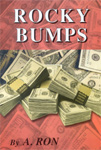
Rocky Bumps
by A. Ron
Introduction
The more the years pass, the more my mind wanders to a time where my life seems to have begun. Just about all of you will recognize the name Philadelphia, the city. When you hear the name you conjure up thoughts of what you've read in the history books. Philadelphia, "The Cradle of Liberty." After all, it was once the capital of a very young United States of America. This is the place where the Declaration of Independence was signed by our nation's founding fathers. The movies have depicted Philadelphia as a city of singers, actors, rags-to-riches boxing champions, and young and ambitious lawyers. Through the years Philadelphia's political machine has had its share of national notoriety. Whatever your knowledge may be about Philadelphia, it is about to be enhanced. This is a story about a different Philadelphia. The city and its people are depicted as they really were, and as they possibly still are. This Philadelphia story is about the people, not bricks or mortar. In order to appreciate this story, one must be familiar with the physical layout of the city.
Philadelphia is comprised of many sections, typically named for their location. These locations fall within geographic areas such as Center City, North Philly, South, Southwest, West, and Northeast. These sections are divided into many diverse neighborhoods. Each neighborhood has its own dialect and specific name.
My story begins in North Philly, in a neighborhood known as Swampoodle. Swampoodle is centered mostly around the corner of Judson Street and Indiana Avenue and the streets immediately surrounding.
That's where I grew up — on the corner that was the focal point of the neighborhood. This is corner where the guys hung out. There was never a dull moment. You went to the corner to validate feelings, bond with the other guys, fit in, and find camaraderie. The corner of J & I could be serene at times, but it was never boring.
I wonder when Billy Penn designed the "City of Brotherly Love" if he ever imagined that certain corners would become the focal point of a particular neighborhood. His design allowed for building rows of about thirty red brick houses, which were attached to each other and separated by an alley in the rear. The alley was lined with small, fenced-in yards. The fronts of houses were eventually faced by other brick row homes lining the opposite sides of the street. In the colonial years, fire had destroyed entire cities, mainly because the houses didn't have sufficient space between them to prevent the spread of fire. Billy's ability to properly space the row houses prevented the city from being destroyed by one great fire. This idea was innovative for the 17th century, and still ingenious three hundred years later. Philadelphia had grown at a tremendous rate. By the early 1960's, the City of Brotherly Love was the third largest city in the United States. Only New York and Chicago surpassed it in population. This growth prompted continual building of red brick row homes. Eventually, these blocks of houses became known as neighborhoods.
I, Rocky Bumps, lived and roamed in these neighborhoods. This is my story.